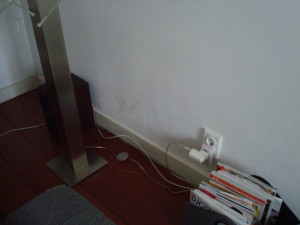Rising damp
There are multiple causes for damp in walls. The main offenders being rising damp, strike through damp, and excess moisture due to condensation. Unfortunately, rising damp is quite common in the Netherlands and can be easily identified by the way it affects walls: the damage first occurs at the ground level and diminishes higher up the wall.
In case of damage across the entirety of the wall, it’s very likely that you are dealing with strike through damp or problems caused by condensation. In older buildings, Stucco will be affected by these types of damage as well. The moisture inside of the walls causes the salts to expand and damage the surrounding brick and mortar work, pushing the Stucco off the wall.
Provocht.nl is specialised in many different techniques of combating these problems and is more than happy to advise you about which of these is suited to your specific situation.
The consequences of moisture inside walls
Do not underestimate the consequences of moisture related problems in your home:
| diminished air quality which can cause health related issues |
| cracks and tears in walls |
| build up of fungi and mould |
| High humidity |
| damage to brick and mortar work |
| damage to Stucco |
| salt residue on walls |
How does moisture enter walls and constructions?
Damp walls are often caused by rising damp, strike through damp or condensation.
Condensation is the result of non-optimal ventilation and high humidity. Damp settles in the coldest spots of ceilings and walls. Usually, mould starts to build up in corners of bathrooms, kitchens, bedrooms and storage spaces. We also regularly encounter mould behind curtains, cupboards and beds due to bad ventilation.
Additionally, rain is able to penetrate the porous outer walls due to damaged or old brick and mortar work. This is called strike through damp. We are able to prevent this from happening by impregnating the outer walls and by renovating the structures front.
However the most common problem is rising damp which enters the brick and mortar work from the ground up. The presence of damp inside of walls causes a multitude of problems such as fungi, mould, salt residue and yellow discoloration on Stucco. Additionally, wooden plinths can also be damaged by moisture inside of walls. It can also cause stale odors in the residence.
Each moisture related problem can have a different cause. That is why a thorough analysis of the situation is needed. Provocht.nl is specialised in providing its customers with the correct diagnosis and reliable moisture readings.
How can rising damp be prevented?
Rising damp can be prevented by installing a water resistant layer. By doing so, water cannot enter the upper construction materials. For this reason, newer buildings are equipped with protective foil. Older buildings however, are not usually equipped with this type of protection which causes moisture to rise through unhindered. This used to be camouflaged by bitumen, paneling, compact cement patches, and lead and aluminium foils. Buildings which are 30 to 40 years old usually have built-in water resistant material called roofing. This material, however, deteriorates over time and lets water enter through cracks and tears.
Rising damp is a common occurrence in older buildings, yet does manifest in newer buildings as well. This calls for a correct approach in order to prevent or revert the damage caused by this problem.
There are two possible solutions: to undercut by the application of a moisture screen, or injection of the walls with a special injection fluid.
Provocht.nl is specialised in providing its customers with the correct diagnosis and reliable moisture readings.





